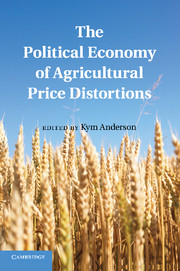Book contents
- Frontmatter
- Contents
- List of Figures
- List of Tables
- Contributors
- Foreword
- Preface
- Abbreviations and Acronyms
- PART ONE Introduction
- PART TWO CONCEPTUAL FRAMEWORKS AND HISTORICAL ORIGINS
- THREE Political Economy of Agricultural Distortions
- FOUR Special Interests versus the Public Interest in Policy Determination
- FIVE Anglo-French Trade, 1689–1899
- SIX Agricultural Protection Growth in Europe, 1870–1969
- SEVEN Determinants of United States Farm Policies
- EIGHT Agricultural Distortions in the Transition Economies of Asia and Europe
- Part Three Political Econometrics: the Past Fifty Years
- Appendix: Coverage and Distribution of Assistance across Countries and Products, 1955–2007
- Index
- References
FOUR - Special Interests versus the Public Interest in Policy Determination
Published online by Cambridge University Press: 05 July 2011
- Frontmatter
- Contents
- List of Figures
- List of Tables
- Contributors
- Foreword
- Preface
- Abbreviations and Acronyms
- PART ONE Introduction
- PART TWO CONCEPTUAL FRAMEWORKS AND HISTORICAL ORIGINS
- THREE Political Economy of Agricultural Distortions
- FOUR Special Interests versus the Public Interest in Policy Determination
- FIVE Anglo-French Trade, 1689–1899
- SIX Agricultural Protection Growth in Europe, 1870–1969
- SEVEN Determinants of United States Farm Policies
- EIGHT Agricultural Distortions in the Transition Economies of Asia and Europe
- Part Three Political Econometrics: the Past Fifty Years
- Appendix: Coverage and Distribution of Assistance across Countries and Products, 1955–2007
- Index
- References
Summary
In any public policy-making process, political and economic forces are at play in resolving the strategic interactions among the public and special interests. A schematic representation of the policy-making process reflecting these forces is represented in Figure 4.1. Historically, the right-hand box has been the domain of political science, whereas the left-hand box has been the domain of economics. At the top of the right box, particular governance structures set the constitutional design establishing voting rules, the rule of law, property rights, laws governing exchange, and more generally the rules by which rules are made. Governance structures also determine the nature and scope of the political feedback mechanisms from groups affected by public policies. In its most expansive representation, any causal analysis of constitutional rules investigates the implications of alternative legal, regulatory, and institutional frameworks, as well as various degrees of political, civil, and economic freedoms. In other words, governance structures set the boundaries for the political-economic link. Over the course of the last few decades, economists have begun to make significant theoretical and empirical advancements in analyzing the link between governance structures, political economics, and the selection of actual policies.
Political-economic analysis seeks to explain the selection and implementation of public policies. This link in the policy-making process endogenizes the instrument settings as a function of governmental bureaucracy and the actions of stakeholders. Interest groups, as agents representing stakeholders, are the units of analysis.
- Type
- Chapter
- Information
- The Political Economy of Agricultural Price Distortions , pp. 105 - 125Publisher: Cambridge University PressPrint publication year: 2010
References
- 8
- Cited by



